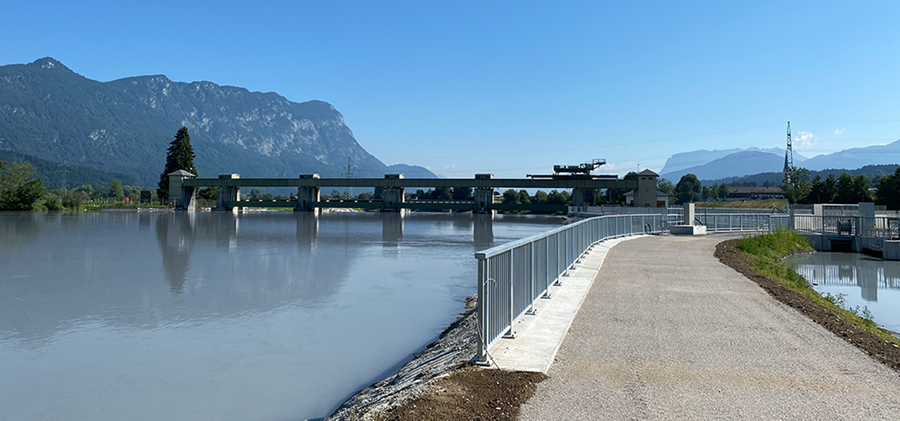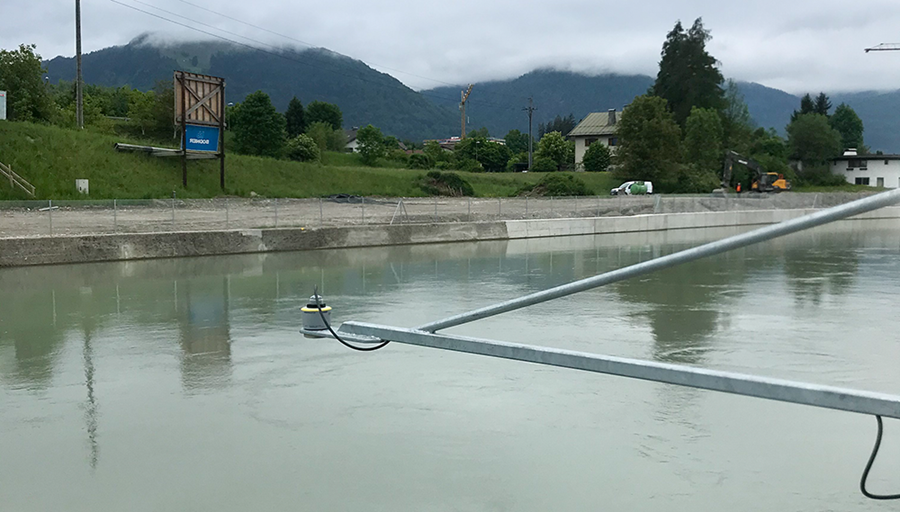VEGAPULS C 21 monitors river levels reliably and accurately
The TIWAG (Tiroler Wasserkraft AG) power station in Kirchbichl, which was adeptly integrated into a loop of the river Inn, has been supplying Tyrol reliably with electricity since the 1940’s. Its location is certainly unique – it separates the meandering 'Inn loop', which is now the path of the residual water, from the main course of the river. This has created a special environment with gravel banks and still water zones that is considered to be one of the last habitats of its kind in Tyrol.
Extensive renovation
Especially clever: The 'doping' water (residual water), released over the weir at the rate of 15 m³/s since May 2018, not only ensures the migration of fish through the Inn loop but is now also used to generate electricity. This not only channels enough water into the Inn loop to support fish and other aquatic life, but also enables an additional 6 GWh of electricity to be fed into the Tyrolean power grid. When the project is finished, the Kichbichl power plant will generate a total of 165 million kilowatt hours of energy per year.
Many years of effective collaboration
When it comes to issues relating to level measurement, TIWAG relies on VEGA, and has been doing so for over 15 years. In the early days, the company was looking for a measuring solution with SIL2 approval and came across VEGASWING, which is actually still in use at the measuring point.
“We appreciate the reliability and, above all, the durability of VEGA sensors and have had many good experiences with them in the past,” recalls Georg Dworschak, who is responsible for system planning and projecting as well as commissioning at TIWAG.
That’s why VEGA sensors are not only installed at the Kirchbichl power plant – measuring instruments from VEGA can also be found in the other power plants belonging to TIWAG. VEGA was also called in when planning for the conversion and expansion of the Kirchbichl plant began.
Ever more accurate measurements required
In the area of level measurement, Dworschak sees a clear trend towards continuous measuring methods and especially radar measurement technology. Nowadays, many more measured values are fed into the process control system for control purposes. At the same time, however, additional data of various types are collected.
“Today there are simply more statutory requirements and regulations. More data is needed than in the past, be it from the main power plant, the doping power station, the wastewater, etc. And this data not only has to be much more precise than before, it also has to be validated. Since everything is automated, an availability of 96 % must be guaranteed,” explains Dworschak, alluding to current developments in automation.
And this doesn’t only apply to the plant in Kirchbichl. Each individual measured value also flows into a high-level Scada system that monitors all the TIWAG power plants in Tyrol – 9 large and 34 smaller ones. The measured values are also reported to the Hydrographic Institute of Austria.
Monitoring along the waterway
Although there is still some construction work to be done in Kirchbichl, the sensors have already passed their field test. Pairs of sensors from the new VEGAPULS C 21 series are now continuously monitoring levels along the waterway: at the inlet channel, at the intermediate measuring point, at the forebay and in the downstream area below the turbine as well as in the pump shafts.
VEGA had just recently added a new compact instrument series to its portfolio of radar sensors. The instruments are also suitable for more price-sensitive applications, such as those found in the water/wastewaterindustry. Their advantage is that, thanks to 80-GHz technology, the radar beam can be aimed at the medium with pinpoint accuracy. As a result, no interfering signals arise in narrow shafts, from deposits on vessel walls or internals such as pipes or pumps. This means that – in contrast to ultrasonic sensors – no false signals occur, so no suppression is needed.
“I was very happy that the new sensor is so compact because that makes it ideal for use especially in the pump shaft. Originally, a radar level sensor of type VEGAPULS WL 61 was planned for this measuring point,” says Dworschak. “I had already thought about the difficulties the installation might present, with possibilities of false signals, but with the new sensor it's no longer a problem.”
The backstory here is that the time required for planning hydropower plants, which are not standard systems due to the topography, is often very long. In the early days of planning, the new compact radar series did not yet exist.
Field test passed
The new compact VEGAPULS series is also characterised by its robustness. Besides being unaffected by temperature fluctuations, vacuum or high pressures, radar sensors are, most importantly, not sensitive to dirt build up. These are all factors that can often cause other types of measuring devices, such as ultrasonic level transmitters, to malfunction. In addition, the series has a fixed cable connection and it is designed with IP66/IP68 protection.
“For the measuring systems of a run-of-river power plant, a flood event is a big challenge,” warns Dworschak. “In the event of a flood, even a redundant measurement can quickly fail because, for example, an uprooted tree is stuck in the inlet.” In the past, one of Dworschak’s colleagues always had to travel to the problem site to inspect the measuring point and quickly take remedial action. During the renovation, the engineering team therefore decided to use a 2 out of 3 measurement solution. “If one sensor fails, I still have two other readings I can rely on,” explains Dworschak. However, VEGAPULS C 21 has astounded the team because, unlike other sensors, it still functions reliably when flooding occurs.
According to Dworschak, the installation itself went off without a hitch. “Only with the radar measurement in the shaft did they see that slight waves occur, but these could be easily tuned out with the filter function.” The compact radar sensors have been delivering reliable and precise measured values since the spring of 2020, proving their practicability in daily operation. This has allowed Dworschak to concentrate on other tasks until the extensive project is completed in November 2020.
Do radar sensors measure well even when the ambient temperature fluctuates? | VEGA talk
Related industries

Wastewater treatment

Drinking water supply
Related products
Export this article
Download as PDFShare this article
Comments ({{comments.length}})
{{getCommentAuthor(comment, "Anonymous")}} {{comment.timestamp | date : "dd.MM.yyyy HH:mm" }}
{{comment.comment}}








